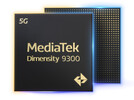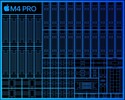MediaTek Dimensity 9300 vs Apple M4 Max (14 cores) vs Apple M4 Pro (14 cores)
MediaTek Dimensity 9300
► remove from comparison
The MediaTek Dimensity 9300 (MT6989) is a high-end SoC for smartphones and tablets based on Android. For the first time, the CPU no longer uses classic energy-saving cores, but only so-called big cores. In this case, four Cortex-X4 cores with up to 3.25 GHz each and four additional Cortex-A720 cores with up to 2.0 GHz each. The manufacturer has also increased the level 3 and SLC cache by 29% compared to its predecessor, which now has a capacity of 18 MB.
In initial benchmarks with a Vivo X100 Pro, the performance is roughly comparable to an Apple A15 or a Qualcomm Snapdragon 8 Gen 2.
The integrated MediaTek APU 790 fully relies on generative AI and aims to accelerate adapted algorithms by a factor of eight. Energy efficiency is said to have been improved by 45 percent. With the MiraVision 990, displays can be operated in Ultra HD at up to 120 Hz and Google Ultra HDR image display (from Android 14) is also supported.
The graphics unit is an ARM Immortalis-G720 MP12 is used.
The SoC is manufactured using the 3rd generation 4-nanometer process at TSMC (N4X).
Apple M4 Max (14 cores)
► remove from comparison
The 14-core Apple M4 Max is a powerful ARM architecture processor (SoC) for laptops and mini-PCs that debuted in Sep 2024. It features 10 performance CPU cores running at well over 4 GHz along with 4 efficient cores running at under 3 GHz. The 32-core M4 Max GPU and at least 36 GB of fast 410 GB/s LPDDR5x on-package memory depending on the configuration are included as well, as is USB 4 and Thunderbolt 5 support.
The built-in 16 core neural engine (up to 38 TOPS) is found across the whole M4 chip family. Furthermore, all M4 processors are thought to be based on the ARM v9.4-A architecture to a certain degree.
Performance
The M4 Max is set to be just a bit faster than the 14-core M4 Pro, meaning it outguns the 16-core M3 Max by a small margin. This is nothing to scoff at, yet it's the new integrated graphics adapters that are the real stars of the show.
Graphics
The 32-core M4 Max GPU has hardware support for ray tracing as well as mesh shading and other modern technologies. It supports external displays with resolutions as high as "8K" and it can HW-decode a few popular video codecs such as h.264, h.265 and AV1.
Its gaming performance is set to be about as good the GeForce RTX 4050 Laptop. Please keep in mind that very few games have been compiled specifically for Apple silicon Macs meaning most titles have to be run via emulation layers. Some of them are displayed with visual artefacts as a result, or don't start at all.
Power consumption
The slower M4 Pro (14 cores) consumes around 80 W when under full load but is happy with just 2 W to 7 W when idling. We presume the 14-core M4 Max needs just slightly more juice than its slower brother to keep going.
The 2nd generation 3 nm TSMC process the M4 Max is built with delivers good power efficiency, as of late 2024.
Apple M4 Pro (14 cores)
► remove from comparison
The 14-core Apple M4 Pro is a powerful ARM architecture processor (SoC) for laptops and mini-PCs that debuted in Sep 2024. It features 10 performance CPU cores running at up to 4.5 GHz along with 4 efficient cores running at up to 2.6 GHz. The 20-core M4 GPU and at least 24 GB of fast 273 GB/s LPDDR5x on-package memory depending on the configuration are included as well, as is USB 4 and Thunderbolt 5 support.
The built-in 16 core neural engine (up to 38 TOPS) is found across the whole M4 chip family. Furthermore, all M4 processors are thought to be based on the ARM v9.4-A architecture to a certain degree.
Performance
In our testing, the M4 Pro delivered multi-thread benchmark scores very close to those of the 16-core M3 Max as well as the Intel Core i9-12950HX. Some small generation-to-generation improvement is obviously present but it's the new integrated graphics adapters that are the real stars of the show.
Graphics
The 20-core M4 GPU has hardware support for ray tracing as well as mesh shading and other modern technologies. It supports external displays with resolutions as high as "8K" and it can HW-decode a few popular video codecs such as h.264, h.265 and AV1.
Its gaming performance is at least as good as that of the GTX 1660 Ti Laptop. Please keep in mind that very few games have been compiled specifically for Apple silicon Macs meaning most titles have to be run via emulation layers. Some of them are displayed with visual artefacts as a result, or don't start at all.
- The Witcher 3 1080p Ultra = 53 fps (close to the GTX 1660 Ti Laptop)
- Baldur's Gate 3 1440p Ultra = 42 fps (close to the GeForce RTX 4050 Laptop)
- Cyberpunk 2077 2.1 Phantom Liberty 1080p Ultra = 40 fps (close to the GTX 1660 Ti Laptop)
Power consumption
When under heavy CPU and GPU load, the SoC briefly consumes around 80 W before settling at around 70 W later. With no load at all, it makes do with 2 W to 7 W. A single P-core of the chip eats around 6 W when under heavy load.
The 2nd generation 3 nm TSMC process the M4 Pro is built with delivers good power efficiency, as of late 2024.
| Model | MediaTek Dimensity 9300 | Apple M4 Max (14 cores) | Apple M4 Pro (14 cores) | ||||||||||||||||||||||||||||||||||||||||||||||||||||||||||||||||
| Codename | Cortex-X4 / A720 | ||||||||||||||||||||||||||||||||||||||||||||||||||||||||||||||||||
| Series | Mediatek Dimensity 9000 | Apple M4 | Apple M4 | ||||||||||||||||||||||||||||||||||||||||||||||||||||||||||||||||
| Series: M4 |
|
|
| ||||||||||||||||||||||||||||||||||||||||||||||||||||||||||||||||
| Clock | 2000 - 3250 MHz | 2592 - 4512 MHz | 2592 - 4512 MHz | ||||||||||||||||||||||||||||||||||||||||||||||||||||||||||||||||
| L3 Cache | 18 MB | ||||||||||||||||||||||||||||||||||||||||||||||||||||||||||||||||||
| Cores / Threads | 8 / 8 4 x 3.3 GHz ARM Cortex-X4 4 x 2.0 GHz ARM Cortex-A720 | 14 / 14 10 x 4.5 GHz Apple M4 P-Core 4 x 2.6 GHz Apple M4 E-Core | 14 / 14 10 x 4.5 GHz Apple M4 P-Core 4 x 2.6 GHz Apple M4 E-Core | ||||||||||||||||||||||||||||||||||||||||||||||||||||||||||||||||
| Technology | 4 nm | 3 nm | 3 nm | ||||||||||||||||||||||||||||||||||||||||||||||||||||||||||||||||
| Features | ARM Immortalis-G720 MP12, Wi-Fi 7 up to 6.5 GBit/s, Bluetooth 5.4, LPDDR5T-9600 @ 4800 MHz, Imagiq 990, AI 5G Modem up to 7 GBit/s, | Unified Memory LPDDR5X-8533 (410 GB/s), 16-Core Neural Engine, Dual Media Engine (Encoding / Decoding: H.264, HEVC, ProRes, ProRes RAW, AV1 Decoding only) | Unified Memory LPDDR5X-8533 (273 GB/s), 16-Core Neural Engine, Media Engine (Encoding / Decoding: H.264, HEVC, ProRes, ProRes RAW, AV1 Decoding only) | ||||||||||||||||||||||||||||||||||||||||||||||||||||||||||||||||
| Architecture | ARM | ARM | ARM | ||||||||||||||||||||||||||||||||||||||||||||||||||||||||||||||||
| Announced | |||||||||||||||||||||||||||||||||||||||||||||||||||||||||||||||||||
| Manufacturer | www.mediatek.com | www.apple.com | |||||||||||||||||||||||||||||||||||||||||||||||||||||||||||||||||
| L2 Cache | 4 MB | 4 MB | |||||||||||||||||||||||||||||||||||||||||||||||||||||||||||||||||
| TDP | 80 Watt | 40 Watt | |||||||||||||||||||||||||||||||||||||||||||||||||||||||||||||||||
| TDP Turbo PL2 | 80 Watt | 46 Watt | |||||||||||||||||||||||||||||||||||||||||||||||||||||||||||||||||
| iGPU | Apple M4 Max 32-Core GPU | Apple M4 Pro 20-Core GPU |
Benchmarks
Average Benchmarks MediaTek Dimensity 9300 → 100% n=2
Average Benchmarks Apple M4 Max (14 cores) → 249% n=2
Average Benchmarks Apple M4 Pro (14 cores) → 240% n=2
* Smaller numbers mean a higher performance
1 This benchmark is not used for the average calculation













